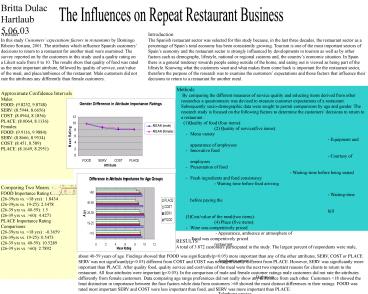The Influences on Repeat Restaurant Business - PowerPoint PPT Presentation
1 / 1
Title:
The Influences on Repeat Restaurant Business
Description:
The Influences on Repeat Restaurant Business. Abstract ... The Spanish restaurant sector was selected for this study because, in the last ... – PowerPoint PPT presentation
Number of Views:34
Avg rating:3.0/5.0
Title: The Influences on Repeat Restaurant Business
1
Britta Dulac Hartlaub 5.06.03
The Influences on Repeat Restaurant Business
Abstract In this study Customers expectations
factors in restaurants by Domingo Ribeiro
Soriano, 2001. The attributes which influence
Spanish customers decisions to return to a
restaurant for another meal were examined. The
survey reported on by the customers in this study
used a quality rating on a Likert scale from 0 to
10. The results show that quality of food was
rated as the most important attribute, followed
by quality of service, cost/value of the meal,
and place/ambience of the restaurant. Male
customers did not rate the attributes any
differently than female customers.
Introduction The Spanish restaurant sector was
selected for this study because, in the last
three decades, the restaurant sector as a
percentage of Spains total economy has been
consistently growing. Tourism is one of the most
important sectors of Spains economy and the
restaurant sector is strongly influenced by
developments in tourism as well as by other
factors such as demography, lifestyle, national
or regional customs and, the countrys economic
situation. In Spain there is a general tendency
towards people eating outside of the home, and
eating out is viewed as being part of the
lifestyle. Knowing what the customers want and
what makes them come back is important for the
restaurant sector, therefore the purpose of the
research was to examine the customers
expectations and those factors that influence
their decisions to return to a restaurant for
another meal.
- Methods
- By comparing the different measures of
service quality and selecting items derived from
other researches a questionnaire was devised to
measure customer expectations of a restaurant.
Subsequently socio-demographic data were sought
to permit comparisons by age and gender. The
research study is focused on the following
factors to determine the customers decisions to
return to a restaurant - (1)Quality of food (four items) (2)
Quality of service(five items) - Menu variety - Equipment and appearance
of employees - Innovative food - Courtesy of employees
- Presentation of food - Waiting-time before
being seated - Fresh ingredients and food consistency -
Waiting time before food arriving -
Waiting-time before paying the bill - (3)Cost/value of the meal(two items) (4)
Place (five items) - Wine was competitively priced - Appearance,
ambience or atmosphere of - Food was competitively priced restaurant
- - Appliance repair
- Bathroom - - Telephone service
- - Parking
Approximate Confidence Intervals Males FOOD
(9.8252, 9.8748) SERV (8.5944, 8.6656) COST
(8.0944, 8.1856) PLACE (8.0064,
8.1136) Females FOOD (9.9116, 9.9884) SERV
(8.8666, 8.9534) COST (8.451, 8.589) PLACE
(8.1649, 8.2951)
Comparing Two Means FOOD Importance Rating
Comparisons (26-39yrs vs. lt18 yrs)
1.8434 (26-39yrs vs. 19-25) 2.3478 (26-39 yrs
vs. 40-59) 1.5 (26-39 yrs vs. gt60) 4.4271 PLACE
Importance Rating Comparisons (26-39yrs vs. lt18
yrs) -0.3659 (26-39yrs vs. 19-25)
0.5473 (26-39 yrs vs. 40-59) 10.5289 (26-39 yrs
vs. gt60) 2.7892
RESULTS A total of 3.872 customers
participated in the study. The largest percent of
respondents were male,
about 40-59 years of age. Findings showed that
FOOD was significantly(plt0.05) more important
than any of the other attributes, SERV, COST or
PLACE. SERV was not significantly(plt0.05)
different from COST and COST was not
significantly different from PLACE. However, SERV
was significantly more important than PLACE.
After quality food, quality service and
cost/value of the meal were the next two
important reasons for clients to return to the
restaurant. All four attributes were important
(plt0.05). In the comparison of male and female
customer ratings male customers did not rate the
attributes differently from female customers.
Data comparing age range preferences did not
really show any difference from each other.
Customers lt18 showed the least distinction in
importance between the four factors while data
from customers gt60 showed the most distinct
differences in their ratings. FOOD was rated most
important SERV and COST were less important than
food, and SERV was more important than PLACE.































